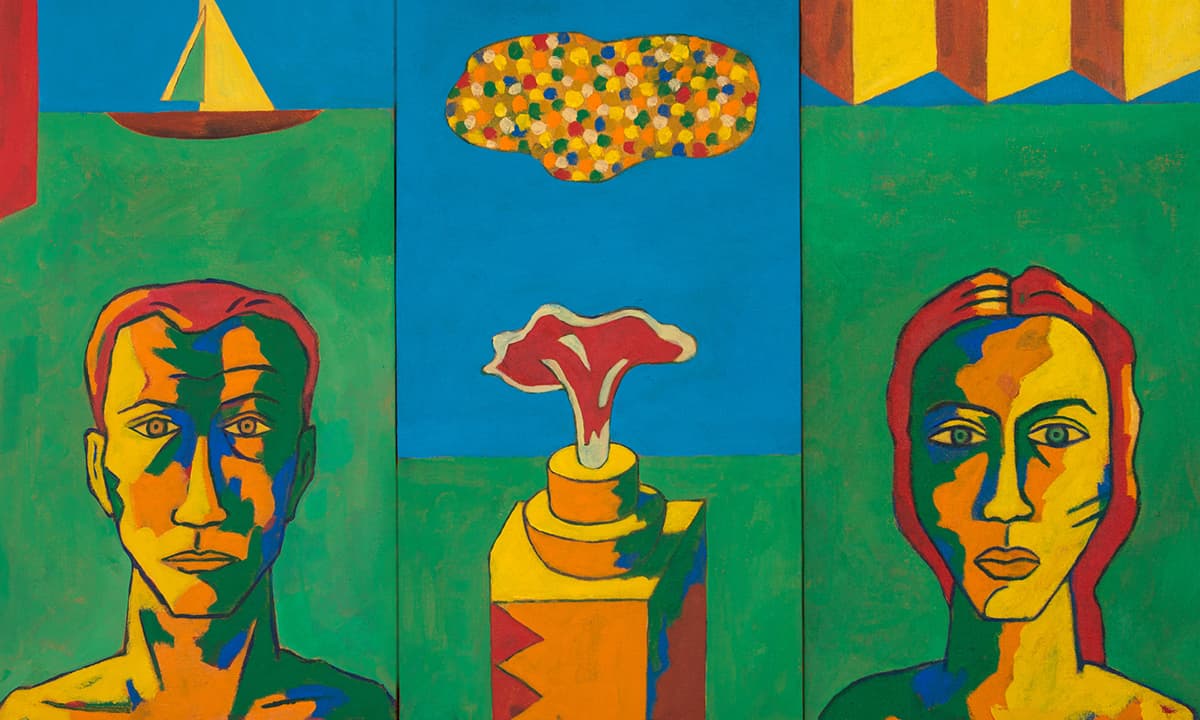
If there is one person fully and solely committed to painting in Pakistan, that is Moeen Faruqi. Self-taught in art with a formal training in science and education from western universities, he has a passion for painting which is evident in each new body of work he produces. His latest show, New Memories, is his first exhibition after three years and is dedicated to his late wife Mahvash Faruqi.
The artist’s earlier works show his desire for, and openness to, learning and discovering new artistic approaches. He is, for instance, quite visibly inspired by German expressionism. There are traces of Cubism in his work too. It is obvious that he has closely studied these art movements. This process of constant learning, in turn, has made his paintings an interesting and engaging experience both for him and for his audience.
Yet, the way Faruqi addresses various elements in his work, especially forms and figures, is uniquely his own. The colours he uses especially stand out. Whether he uses oils or acrylics, he never mixes and merges them, and still ensures that this reductive application of paint does not give his work the feel of being unfinished. His subjects are always depicted as fully matured.

This unique approach is possibly the result of Faruqi’s intuitive response to the creative process which, in his case, is neither tamed nor inhibited by formal training. His eagerness to allow his style to evolve can be seen in shifts in his modes and methods — such as the varying scales and shapes of his canvases and his gestural strokes coupled with an almost calculated application of paint. Together, these create a visual impression that transports the viewer to another world which, despite being different, still generates a vague feeling of instant connectivity.
There could be several reasons for this feeling of connectivity. Perhaps it is because Faruqi’s work captures mundane imagery of everyday life. He paints common experiences people have in their day-to-day lives. It could also be due to the truthfulness of the emotions he presents through his images. The viewers may find a reflection of themselves in the sullen characters posing in each of his framed compositions, confronting them with feelings they normally do not deign to entertain.

The sense of loss and alienation is not a new subject for Faruqi. His previous works depict people who suffered the loss of home and belongings after the partition of the Indian subcontinent. A whole generation that migrated to Pakistan was never able to fully recover from the pain that resulted from the experience of migration. This generation left behind not only its homes but also its neighbourhoods, friends and, in some cases, even family members.
Such a powerful event as the Partition can have effects that last longer than one can imagine, seeping into the hearts and minds of many generations. Characters in Faruqi’s paintings appear to be facing a similarly lasting sense of loss. Even though surrounded by theatricality – often portrayed through a vibrant setting – people in his work are alone and solitary. They are carrying a lot of weight and, while they do not show much of an expression, their inner turmoil is made visible through their large insomniac eyes and pursed lips.
It makes perfect artistic sense to place such complex and mysterious characters within the setting of a city that does not sleep. Faruqi, therefore, locates his characters in Karachi which, due to its association with the early migrant generation, is also immensely relevant to the experience of loss. The city, with its multi-ethnic culture, offers a layered narrative that the artist uses effectively in his work. His eccentric figures navigate the cacophonous city – its social events, private parties and get togethers – with a sombre grace.

Faruqi shows this contrast between gaiety and sadness through a strange combination of bright and flamboyant backdrop colours with pallid faces of his characters. While everything around his characters is very loud, they themselves are quiet and withdrawn. They, thus, are simultaneously a part of, and separated from, their surroundings. The evocation of these mixed feelings is what makes Faruqi’s works poetic and allows him to generate a powerful feeling of melancholy.
The exhibition also includes some drawings which are a rare treat because Faruqi has seldom shown them publicly in the past. They add a new dimension to the symbolism in his work. The dissipation of colour in them could be interpreted as the loss of joy and cheerfulness of life.
The way Faruqi has managed to highlight gloom and dejection through his erratic imagery makes the works displayed in the exhibition strong in their execution and powerful in their impact. They are rich in both the stories they tell and the emotions they depict.
This article was published in the Herald's May 2019 issue. To read more subscribe to the Herald in print.







